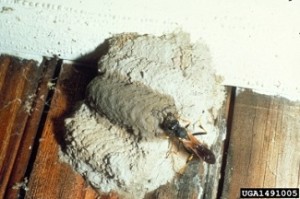Mud Dauber Wasps Are Not Much of a Threat
By Chris Williams on June 29, 2015.

Black and Yellow Mud Dauber building its nest.
We have some kind of wasp or bee making a nest out of dirt on our front porch. We scraped it off once but the insect came back and started over. Is this anything we need to be worried about? Will it sting? K.M., Stowe, MA
I’m pretty sure you’re talking about a mud dauber wasp. We have three different types in Massachusetts: the black and yellow mud dauber that builds a mud nest about 4 inches long by 2 inches wide, the black organ pipe mud dauber whose nest is a series of mud tubes attached side by side, and the blue mud dauber that doesn’t build its own nest at all but parasitizes the nest of another.
Mud Daubers Are Not Yellowjackets!
Of all of the wasps that can become pests around homes, mud daubers are the most docile and least aggressive. Unlike other wasps, they do not defend their nest when threatened, and so rarely sting. Mud daubers are solitary wasps so there is only one or two wasps per nest to worry about. That said, if you put your hand down on top of one, you would probably get stung. Unless the nest is in a location where you are constantly interacting with the wasp, like right over the doorway, you’re probably fine. Besides, once the mud nest is constructed, the wasp moves on and all will be quiet again (see How Do Mud Daubers Build Their Nests?).
Nest Building is a Dirty Job
A female mud dauber builds a nest all by herself (the male actually waits inside the nest) by gathering mud from pools and puddles. She rolls a piece into a ball and carries it in her jaws to be plastered onto the growing nest. As she constructs each of several nursery cells, she provisions them with a paralyzed spider and lays an egg.
Inside the sealed mud nest, wasp larvae feed on their spider meals. When the larvae are fully grown, they pupate inside the mud tubes. Some mud daubers will emerge from the nest in mid-summer by chewing a circular exit hole. Others spend the winter in the nest in the pupal stage, emerging as wasps in the spring.
Mud daubers like to nest in sheltered, covered sites such as under eaves, porch ceilings, in open sheds, barns, or garages, You can scrape off completed nests, or you can sit back and observe the process. If you have mud dauber nests on your home with holes in them, those larvae have emerged and the nest is empty. If you have a lot of mud daubers nesting in the same site (and they tend to return year after year), you can have an exterminator treat the site to keep them from nesting there.